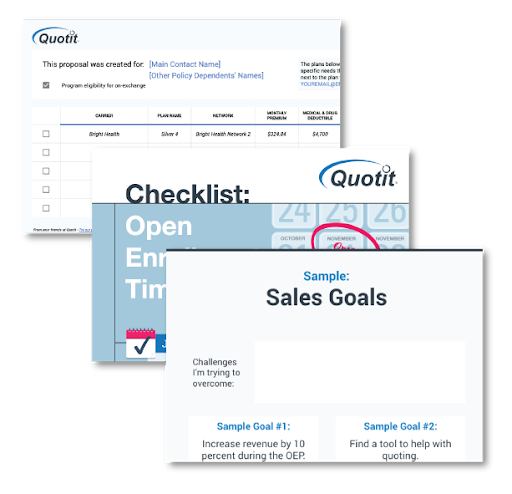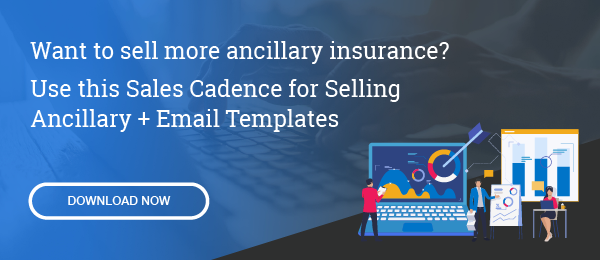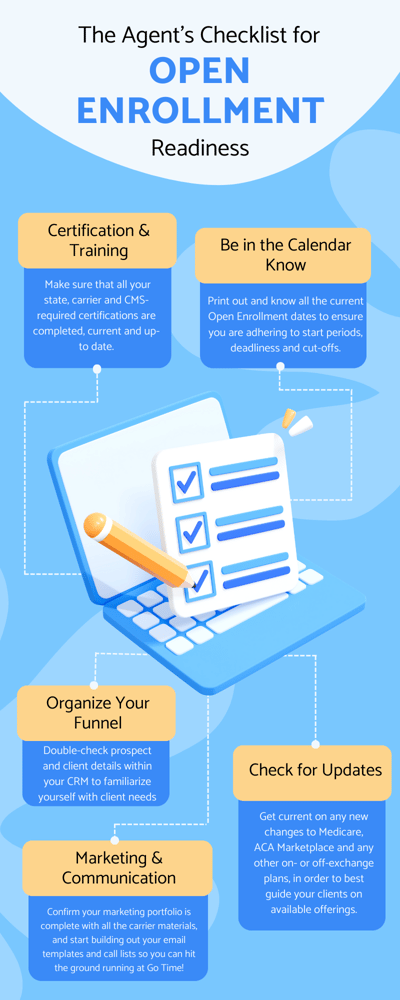The good news is that getting thoroughly prepared for open enrollment isn’t impossible. With the right approach, you can build an insurance-selling machine that meets the needs of your clients while ensuring your sales team isn’t overworked.
Before we dive in, we recommend setting goals to drive your OEP and AEP sales, marketing, and operational efforts this year. We've made templates for you (with examples).
With that in mind, let’s take a look at four ways your agency or brokerage can start preparing for open enrollment today. The sooner you master these elements, the better positioned your company will be to thrive during the open enrollment period—this year and for many years to come.
1. Keep track of changes in the law, health insurance plans, and care
Although the open enrollment period is predictable—you can count on it at the end of each year—it’s also unpredictable in the fact that health insurance laws, plans, and care options change every year.
For example, in a partnership with the private sector, last year, the Centers for Medicare & Medicaid Services developed a new enhanced direct enrollment program that enables consumers to buy health insurance coverage on federal exchanges.
This program represents an improvement on the direct enrollment pathway that had been in place since 2013, which allowed agencies and brokerages to help customers find plans on HealthCare.gov. Now, under the enhanced program, consumers can buy Medicare coverage and ACA plans directly from agencies and brokerages like yours on your website.
When you partner with the right web broker entity, you won’t have to do any heavy lifting to take advantage of this new program. The software will have this functionality enabled during the open enrollment period, reducing time and errors for brokers and agencies looking to sell insurance to clients under these programs.
This change represents just one major shift in the health insurance industry. With so many changes going on, it is critical to keep track of all of them. Otherwise, you may leave money on the table.
Leading agencies and brokerages stay on top of all of these market shifts so they can be trusted advisers to their clients—as well as great resources for any prospective clients who may reach out with questions.
This all sounds great, but how exactly do you stay on top of such things?
It starts with taking a proactive approach to education. Incorporate continuous learning into your regular workflow to keep on top of what’s going on in the industry. Some easy ways to do that are as follows:
- Attend popular health insurance conferences to network with industry thought leaders and expose yourself to new ideas and technologies.
- Listen to health insurance podcasts to stay on top of trends and industry developments.
- Find a few trusted sources of industry news and check them out periodically.
Do your due diligence to determine which conferences, podcasts, and news sites are best suited to your agency or brokerage’s unique needs. That way, you keep your fingers on the pulse of any major changes in health insurance and healthcare technology—reducing the likelihood that you’ll ever get caught off guard by any major developments.
 2. Communicate with your clientele throughout the year
2. Communicate with your clientele throughout the year
If you’ve ever bought your own health insurance, you know how overwhelming the experience can be.
You browse a number of plans and do complicated math equations to determine how much yearly premiums will be against how high deductibles, copays, and out-of-pocket maximums are. You need to figure out whether your doctor is in-network or out-of-network, and you need to figure out prescription drug benefits. The list goes on and on, and of course, these numbers and considerations change every year.
Figuring all of that out is a massive endeavor. But wait—there’s more!
Beyond simply determining which health insurance plan makes the most sense for their specific situation, clients also need to keep track of how insurance laws change. For example, the Affordable Care Act’s employer mandate means that a business with at least 50 full-time employees needs to offer health insurance to at least 95 percent of its employees and their dependents who are 26 years old or younger. Otherwise, they could be fined. This is information that a new small-business owner might not be aware of.
Because most health insurance customers simply don’t have enough time to stay on top of all of these changes—and many of them might not be familiar with insurance terminology in the first place—your agency or brokerage should communicate with your clients throughout the year, keeping them informed of all changes in laws and coverage as well as educating them on health insurance basics.
For example, during the spring or summer, you might send out an email blast to your clientele with the following subject line: “7 Health Insurance Terms You Need to Know.” Your email could include a link to a blog post that defines common terms such as deductible, premium, copay, coinsurance, in-network, out-of-network, and out-of-pocket maximum.
We've created email templates that will help you stay in touch with your leads and clients throughout OEP. Save your copy here!
The better you communicate with your clients throughout the year—and the more you keep them engaged—the less likely they will be to get caught off guard when the open enrollment period comes around. And, of course, the more likely they’ll be to buy health insurance from you.
3. Offer ancillary insurance products so you can upsell your clients
Does your health insurance agency or brokerage sell only health insurance? If so, you’re potentially missing out on plenty of money.
Because the open enrollment period puts you in touch with a number of clients, you need to capitalize on the opportunity by trying to upsell them when the opportunity presents itself. Why not present your business as a one-stop shop for all insurance needs? By adding vision, dental, disability, accident, Medicare Advantage, and Medicare Supplement plans to your agency or brokerage’s product portfolio, you can do a better job of meeting your clients’ insurance needs while bolstering your bottom line.
You might be thinking that this all sounds great, but selling health insurance on its own is hard enough. How, then, can you add all of these other insurance products to your portfolio and not get burned out?
Thanks to new tools designed specifically for agencies and brokerages like yours, doing that is nowhere near as hard as you might think.
4. Use technology to expedite the quote and enrollment process
In the age of smartphones, ubiquitous connectivity, and lightning-fast networks, consumers expect instant gratification and personalized experiences. Thanks to Amazon, they’ve learned that they should be able to buy something the moment they want to buy it—not during some arbitrary block of time when a company happens to be open for business.
This doesn’t mean that your agency or brokerage needs to be staffed 24 hours a day—quite the contrary.
Thanks to innovative new software solutions, your business can sell insurance products around the clock—even when you’re sleeping.
For example, leading quote and enroll solutions enable customers and prospects to shop and compare health insurance plans at their convenience. This is a big deal—especially considering the fact that 72 percent of clients have looked online for health insurance.
At the same time, these solutions let agencies and brokerages sell insurance plans from carriers across the country. Not only does this give clients and prospects as many choices as possible, but it also makes it easy to add ancillary health insurance products to your portfolio. This plug-and-play approach is much more efficient than hopping from one carrier site to another when a prospect is on the phone.
The open enrollment period is exceptionally busy, but technology can also make sure your team doesn’t burn out.
For example, a customer relationship management (CRM) solution can automate client outreach and repetitive tasks. To illustrate: With a CRM system in place, agents can automatically send personalized emails to all of your prospects and clients, reminding them that the open enrollment period starts in two months.
This is something you simply cannot overlook—email marketing is one of the most important aspects of a successful enrollment period. With the right approach, you can gently nudge and remind your clients and prospects that they will need to start thinking about their healthcare needs for the upcoming year. CRM tools can automate this outreach entirely—giving agents more time to focus on other important areas.
By investing in the right technologies, your health insurance business can operate more efficiently and effectively, setting yourself up for success when the busiest time of the year approaches while keeping employee morale high.




